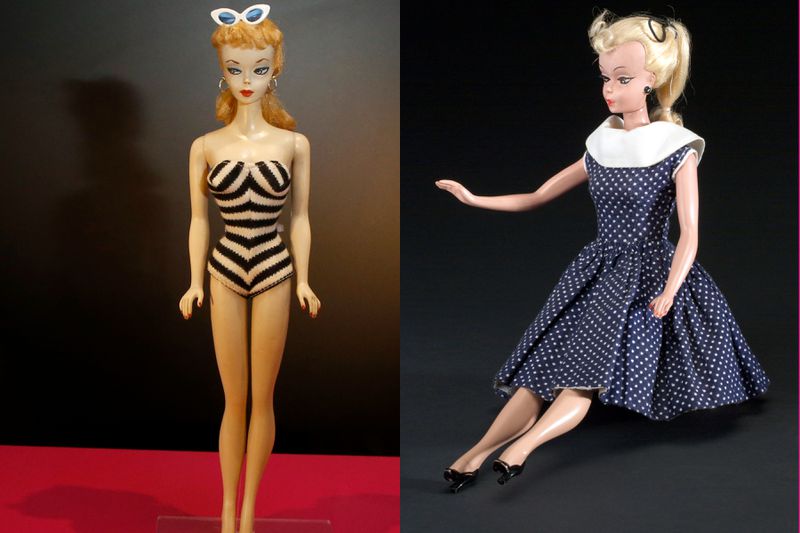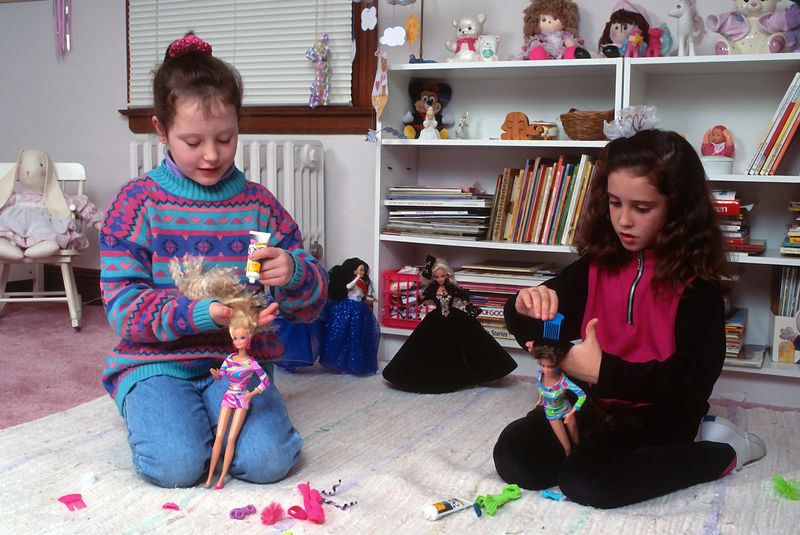
Why Barbie inspires some of childhood’s weirdest games.
The earliest Barbie commercial ever on TV is instructive. It tells you exactly what Mattel thought you were supposed to do with your Barbie doll when the ad aired in 1959: You were supposed to aspire to be her.
“Someday I’m gonna be exactly like you,” sings a girl’s voice in the ad, as Barbie cradles a bouquet of flowers like a pageant queen. “Till then, I know just what I’ll do: Barbie, beautiful Barbie, I’ll make believe that I am you.”
It’s an odd ad, mostly because no one I know who played with Barbies was ever willing to admit to aspiring to be like Barbie. That was not what Barbie was for.
Barbie was for ripping apart and putting inexpertly back together. She was for removing heads and limbs. She was for microwaving. She was for chopping off her doll hair. She was for doll orgies. She was an ersatz body whose purpose was to allow her owner room for experimentation. As Jezebel put it in 2007, “Growing Up, Everyone Did Dirty Things With Their Barbies.”
The cast of Greta Gerwig’s buzzy new Barbie movie knows exactly how kids play with these toys.
“I witnessed my sister and her friends do some stuff with those Barbies, and I think we all did,” said Kate McKinnon in a June interview with Fandango, widening her eyes at the camera in a way that suggested that the “stuff” was probably pretty dirty. Which isn’t a bad thing, McKinnon insisted: “It’s imagination, it’s a way of expressing your innermost desires, and things that you’re exploring about yourself and about the world. It’s a very good tool for children to have.”
“It was a tool of aggression, too,” added Issa Rae in the same interview. “My sister had a My Size Barbie, and I don’t know what it was, maybe because it was close to our size, but we fucked that Barbie up.”
Nearly everyone who plays with Barbie fucks her up in one way or another. A 2005 study from the University of Bath led by Agnes Nairn found that children from the ages of 7 up will almost universally describe getting violent with their Barbie dolls with glee and pride. “They’re not particularly cool unless you torture them,” explains one child to an interviewer.
With Barbie now set to become one of the summer’s biggest movies, the time is ripe to look back to murky childhood memories. Let’s remember exactly what it means to play with Barbie.
The origins of Barbie

Getty Images
Barbie was invented by Mattel co-founder Ruth Handler. She was inspired (the story goes) by watching her young daughter, Barbara “Barbie” Handler, play with paper dolls of adult women, daydreaming out loud about the kind of woman she would grow up to be. Small Barbara would have loved to play with a fully fledged plastic adult woman doll, Handler realized, but the only three-dimensional dolls available at the time were baby dolls. The market had a gap, and by 1959, Barbie was there to fill it: a doll for girls that would let them practice being grown-up.
That’s the official creation myth, but there’s another, less wholesome version of the story. Mattel’s first Barbie bears a startling resemblance to a German doll named Lilli, known for her prodigious bosom, platinum blonde hair, and painted-on eyeshadow. Lilli was a character from comic strips, a call girl with a penchant for double entendres. Her spinoff doll line was decidedly for adults. Like the German equivalent of a mudflap girl, Lilli’s idealized figure made her a popular item to buy at tobacco shops or distribute as a gag gift at bachelor parties. Lillis dangled from the rearview mirrors of men’s cars across the country.
According to some historians, Handler noticed Lilli when 15-year-old Barbara became interested in the dolls during a family trip to Switzerland in 1956. Handler took three of the dolls back home with her, and three years later, Barbie was born, blonde and buxom and spackled with cosmetics.
Regardless of whether the story was true or not, in 1961, Lilli’s parent company G&H sued Mattel for patent infringement. The case was dismissed, and in 1964, Mattel bought G&H’s Lilli copyrights for $21,600, or about $200,000 in today’s dollars. Forever after, Lilli would be one of the buried secrets of Barbie: The plastic body little girls are given to practice being grown-up with is the same as the plastic body grown men hang from the rearview mirrors of their cars as a dirty joke.
At the same time, Barbie’s wholesome all-American image remains the key to her US marketability.
“My whole philosophy of Barbie was that through the doll, the little girl could be anything she wanted to be,” wrote Handler in her 1994 autobiography. “Barbie always represented the fact that a woman has choices.” Hence Barbie’s dozens upon dozens of careers: astronaut, ballerina, doctor, president, architect, baseball player, and on and on and on.
Yet what people get up to with their Barbies tends to be a little weirder than using them to pretend to be president. Frequently, Barbie games are about sex and violence.
“Plenty of us have admitted to dismantling our Barbies in one way or another,” wrote Jezebel after surveying its commentariat in 2009. “Chewing her delicious feet is the most popular admission, though chopping off her hair, seeing if she can ‘fly’ from the car window, and letting her get ‘a tan’ in the microwave are also on the list.”
“How did I — the daughter of a feminist and working woman, myself a future feminist and a generally liberal, Prius-driving recycling lady — play with my Barbie?” mused Sarah Haskins in the Washington Post the same year. “I took off all her clothes and sent her looking for love. My Barbie got around.”
“I think I *mainly* did normal stuff like have them go shopping, go to school, go for a drive, etc.,” said a Reddit commenter in 2023. “But I always had to do some weird sexual stuff every once in a while. In fact, I was super vindicated when I was playing Barbies for the first time with one of my elementary school friends and it devolved into a lesbian orgy and I was like, ‘omg, I’m not the only weirdo!’”
Other commenters on the thread chimed in with agreement.
One who owned the Barbie safe recalled staging robberies and, since she also had a Barbie-sized gun, “staged some murders too.” Of course, in addition, “Ken humped Barbie.”
“Locked ken in the barbie dreamhouse shower and made my barbies [scissor emoji],” said another.
Not every toy gets this kind of treatment. When Nairn ran her 2005 study on how kids react to different toys, she found that they described being more violent with Barbie than with anything else, even the 7-year-old girls. “The most striking thing about the discourse which surrounded the forty year old iconic Barbie was the rejection, hatred and violence which the doll provoked,” Nairn wrote. (Anecdotally, kids also seem to get weird with Sims, another highly manipulatable representation of adult life, but they don’t feature in Nairn’s study.)
Something about Barbie seems to spark more sadism than all the other contents of the toy box. Yet at the same time, Barbie is beloved to the point of ubiquity. Mattel estimates that more than 100 Barbies are purchased in 150 countries every minute.
So why do we use Barbie like this?
The semiotics of Barbie

Yvonne Hemsey/Getty Images
In their study, Nairn et al repeatedly ask the children they’re talking to why they hate Barbie in particular. They tend to give fairly consistent responses: Barbie, the children declare, is for babies and girly girls, and this is what makes her uncool, revolting, in need of mutilation. The children know, after all, what Barbie is for. She exists to teach young girls how to be feminine women.
In his 1977 book The Uses of Enchantment, child psychologist Bruno Bettelheim theorizes that children need to use symbols and story tellings — often darkly violent and sexual ones — in order to process their emotions about ideas they don’t yet fully understand. That, he writes, is why it’s so important for children to hear fairy tales in their dark and bloody pre-Disney forms.
It’s for this reason that children tend to find the vengeful elements of old fairy tales gratifying rather than disturbing, as they often are for adults. A child nursing a grudge against a parent can be satisfied by hearing about how Snow White’s evil stepmother was forced to dance in red-hot iron slippers until she burned to death. A child who feels ashamed of their own misbehavior can comfort themselves by hearing about how Cinderella’s wicked stepsisters were justly punished for their own bad deeds.
For Bettelheim, toys are central to this kind of unconscious processing, because they are physical objects that can become symbols of whatever problem the child is facing.
“The child must somehow distance himself from the content of his unconscious and see it as something external to him, to have any sort of mastery over it,” Bettelheim writes. “In normal play, objects such as dolls and toy animals are used to embody various aspects of the child’s personality which are too complex, unacceptable, and contradictory for him to handle. This permits a child’s ego to gain some mastery over these elements.” Barbie, with her small scale and her many tiny accessories, is an ideal object for a child to have mastery over: so small and cute you just want to rip her to pieces.
For little girls, Barbie is one of the most potent symbols there is of the problem of being an adult woman. Her impossible body is a three-dimensional dirty joke. Grown-ups tell you that all her careers make her beautiful and empowering, but all your peers know that her femininity makes her humiliating. You’re supposed to want to be her; you’re supposed to think she’s stupid. You’re supposed to want to be a woman who men think is attractive; you’re supposed to think that women men find attractive are stupid.
You rip her apart; you make her have sex; what else can you do with her? What else can you do with the problem of what you’re going to grow up to face?
So in the end, Mattel was right back in 1959. Barbie, beautiful Barbie, we made believe that we were you.
----------------------------------------
By: Constance Grady
Title: The long history of kids decapitating their Barbies and making them kiss, explained
Sourced From: www.vox.com/culture/23800314/why-kids-murder-their-barbie-dolls
Published Date: Thu, 20 Jul 2023 12:30:00 +0000






